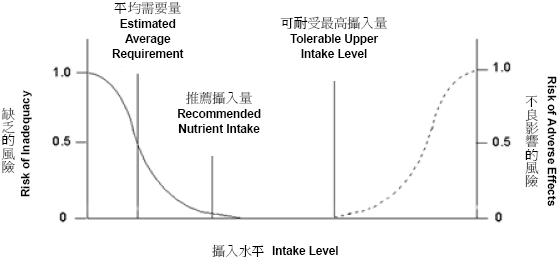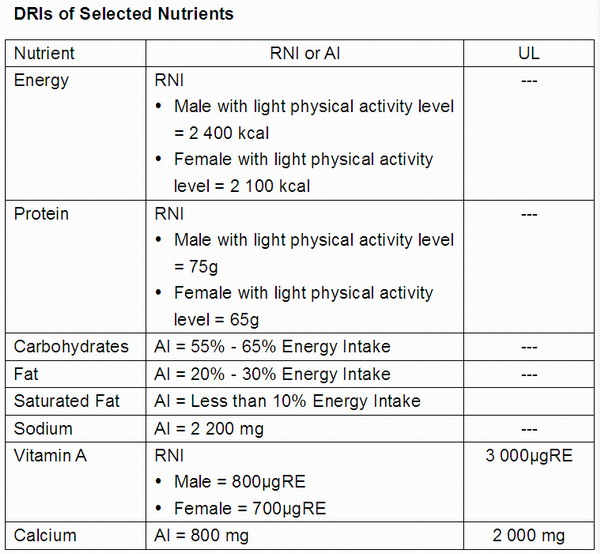
Food Safety Focus (28th Issue, November 2008) – Food Safety Platform
Nutrient and Health - Maintain Optimal Nutrient Intake
Reported by Ms. Jacqueline Fung, Scientific Officer,
Risk Communication Section, Centre for Food Safety
Nutrients are substances in foods that provide energy and are used for bodily growth, repair and maintenance. Assessing nutrient intake is an important part of health assessment at both the individual and population levels. Nutrients are essential for life. But like contaminants in food, they may also do harm to our body. In such case, assessing nutrient intake is two-fold, i.e. evaluating the risk of inadequacy and, on the other hand, the risk of adverse effects due to excessive intake. For example, low intake of vitamin A may cause night blindness, whereas high intake may cause liver abnormalities.
Starting from this issue, we will introduce a new series on nutrition. To begin with, we will introduce the "Dietary Reference Intakes (DRIs)", which consist of reference points regarding recommended nutrient intake levels for assessing the risk of inadequacy and the tolerable upper intake levels for assessing the risk of adverse health effects.
From Adequacy to Excess; From Benefit to Risk
Decades ago, the adequacy of nutrient intake was the main focus of nutritional assessment. Back then, health authorities from different places established recommended intake levels for nutrients as indicators of nutritional adequacy. Apparently, now we hear less about nutrient deficiency and starvation in our society, but more on obesity and chronic diseases as a result of malnutrition and sedentary lifestyle. Furthermore, an upsurge of processed foods, increase in food fortification and the rapidly expanding use of dietary supplements have increased the risk of adverse health effects due to excessive intake. To cover both ends of the spectrum, a set of intake values, now called "DRIs", was expanded to include the tolerable upper intake level.
Categories of Dietary Reference Intakes
Although the concepts of DRIs established or adopted by different countries are very much the same, different sets of DRIs may have different values since there are different nutritional needs and public health concerns in different communities. We, in this series of articles, will introduce and use the Chinese DRIs as they are deemed most appropriate for the majority of people in Hong Kong .
The Chinese DRIs were established by the Chinese Nutrition Society in 2000 with an aim to guide individuals' and population's nutrient intakes. Furthermore, they are used as benchmarks to evaluate the nutritional status at the individual and population levels.
Dietary Reference Intakes (DRIs) is a collective term of the four different sets of reference values, namely Estimated Average Requirement (EAR), Recommended Nutrient Intake (RNI), Adequate Intake (AI) and Tolerable Upper Intake Level (UL).
Estimated Average Requirement (EAR) - The EAR is the average daily nutrient intake value that is estimated to meet the needs of half the healthy individuals in a given age and gender group.
Recommended Nutrient Intake (RNI) – The RNI is the daily nutrient intake value that is estimated to meet the needs of nearly all (97 to 98 per cent) healthy individuals in a given age and gender group. Assuming the nutrient requirements are normally distributed, the RNI is calculated as follows:
RNI = EAR + 2 x Standard Deviation (SD)
Adequate Intake (AI) – When sufficient scientific evidence is lacking, the EAR cannot be determined, in turn the RNI cannot be calculated. In such case, the AI is provided. The AI is based on experimental data or observed nutrient intake by a group of healthy people, with an assumption that the intake is adequate to promote health. Obviously, the AI is less certain than the RNI as there is insufficient scientific supporting data. A nutrient has either a RNI or an AI, but not both.
Tolerable Upper Intake Level (UL) – The UL is the highest nutrient intake value that is likely to pose no risk of adverse health effects for individuals in a given age and gender group. It is not intended to be a recommended level of intake. The UL is established when strong evidence supporting the relationship between a nutrient and the adverse effects is available. No ULs are set for macronutrients (carbohydrates, protein and fat). One of the main reasons is that multiple risk factors, such as lack of physical activities and smoking, contribute to the development of a chronic disease. Thus, it is not possible to determine a defined level of intake as the UL.
Relationship of Dietary Reference Intakes to Risk of Nutrient Inadequacy and Risk of Adverse Health Effects

In summary, both the AI and RNI are intended to meet the needs of almost all healthy individuals in a given age and gender group, as such, both values are considered to be the goals of nutrient intake. As regards the risk of adverse health effects, the UL can be used as a guide to limit the intake levels. The risk of adverse effects increases as the intake increases above the UL.

We shall examine the chemical structures, functions, food sources and related health issues of some nutrients, such as fat, cholesterol and carbohydrates in the following issues. It is our goal that readers, with the basic knowledge on these nutrients, would be able to better apply the common nutrition education tools, such as food guide pyramid and nutrition labels.


